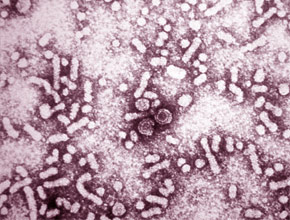

The new vaccines should have the same efficacy as the injectable immunization but are cheaper and easier to administer
The new vaccines should have the same efficacy as the injectable immunization but are cheaper and easier to administer.
The new vaccines should have the same efficacy as the injectable immunization but are cheaper and easier to administer.

The new vaccines should have the same efficacy as the injectable immunization but are cheaper and easier to administer
By Elton Alisson
Agência FAPESP – The Butantan Institute should soon begin clinical trials of an oral vaccine against hepatitis B, which promises to have the same efficacy as the injectable vaccine but will be easier to administer and will cost less.
The announcement came from Osvaldo Augusto Brazil Esteves Sant’Anna, researcher at the Butantan Institute, during the 65th Annual Meeting of the Brazilian Society for the Progress of Science (SBPC) in Recife held on July 23, 2013.
“The protocol for beginning the tests of the vaccine is being prepared. The vaccine is important globally because it changes the paradigm of vaccination,” said Sant’Anna.
According to the researcher, one of the challenges of oral vaccines is ensuring that the antigens (responsible for immunization) reach the immune system, located largely in the intestine.
This is challenging because it is difficult for vaccines to survive the gastric juices, which have very high acidity and contain proteases (enzymes that break down proteins), and reach the intestines intact, where the immune response actually occurs. For this reason, there are few examples of currently used oral vaccines, one of which is the Sabin vaccine, utilized to immunize children against polio.
In collaboration with Marcia Fantini, a professor at the Physics Institute of Universidade de São Paulo (USP), Sant’Anna developed a way of encapsulating and protecting antigens from the action of the gastric juices.
With the use of nanotubes made of silica, the second most common element found in nature, researchers managed to help the antigens in the hepatitis vaccine cross the gastric barrier and reach the intestines intact.
“The silica nanotubes have a structure similar to honeycombs, with pores where it is possible to insert and encapsulate antigens,” explains Sant’Anna, who coordinated the National Institute of Science and Technology in Toxins – one of the INCTs funded by FAPESP and the National Council of Scientific and Technological Development (CNPq) in São Paulo State.
The first tests of vaccines with silica took place in mice between 2001 and 2002 using a recombinant vaccine (made of a genetically altered virus) against hepatitis B produced by the Butantan Institute.
Initially, the animals received the vaccine in the injectable form. In 2007, the scientists began tests on oral vaccines in animals using the recombinant vaccine against hepatitis B with silica, which was formulated and prepared by the Butantan Institute and manufactured by the pharmaceutical company Cristália.
The development of the vaccine resulted in a joint patent request filed by the Butantan Institute and Cristália. “We found that the oral vaccine with silica greatly improved the immunological response of the animals. It very effectively immunized against hepatitis B,” affirmed Sant’Anna.
Clinical trials with humans are slated for conclusion between 2018 and 2020. The new vaccine should reach the market within 10 years. In partnership with Cristália, the Butantan Institute is developing the protocol for these clinical trials.
Application in new vaccines
The production technology for creating vaccines with silica is being tested for other applications. Currently, the researchers are testing technology to develop other vaccines, including for example, a vaccine containing intimin – a protein found in bacteria that colonize the human intestinal flora – to fight infectious diarrhea. “We know that the vaccine containing intimin works well orally,” said Sant’Anna.
The group of researchers is also conducted preliminary tests with the rabies vaccine, but they have not yet tested an oral formulation.
The results of these tests indicate that silica potentiates vaccine activity. Furthermore, it reduces the toxicity of toxins like diphtheria toxin, which is used to produce anti-diphtheria serum in animals.
“Because silica encapsulates the antigens, it is possible to use it to administer diphtheria toxin to horses, for example, to produce anti-diphtheria serum,” comments Sant’Anna. “If the toxin is given without silica or another form of protection, the animal dies.”
In human vaccines, one of the advantages of oral doses, according to the researcher, is a reduction in the economic and operational costs of their administration.
Eliminating the need for syringes and needle use significantly reduces the price of the vaccine. Furthermore, it is not necessary to train nurses and other medical professionals to use it, unlike injectable vaccines. “Health professionals need only be aware of how to give a vaccine orally, like they do with the Sabin vaccine today,” commented Sant’Anna.
The development of silica vaccines will integrate the research line at the Center for Research on Toxins, Immune-Response and Cell Signaling (CeTICS) – one of the FAPESP-funded Research, Innovation and Dissemination Centers (CEPIDs) – where Sant’Anna is one of the lead researchers.
One of the projects that the researcher intends to develop under the auspices of CeTICS is a comparative study on energy expenditure by humans immunized orally and by other routes of immunization.
“An organism does not expend as much energy when receiving an oral vaccine. Furthermore, the mouth is a natural route of infection, and it is therefore an appropriate route for vaccine activity,” he noted.
Republish
The Agency FAPESP licenses news via Creative Commons (CC-BY-NC-ND) so that they can be republished free of charge and in a simple way by other digital or printed vehicles. Agência FAPESP must be credited as the source of the content being republished and the name of the reporter (if any) must be attributed. Using the HMTL button below allows compliance with these rules, detailed in Digital Republishing Policy FAPESP.





